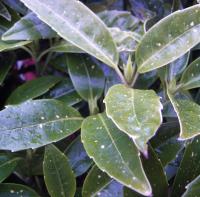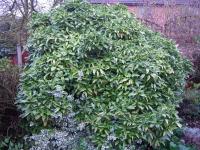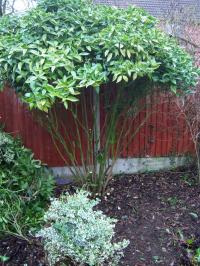Spotted Laurels and How to Prune Them
 The spotted laurel's foliage is undoubtedly its main feature
The spotted laurel's foliage is undoubtedly its main featureLearn about these tough, versatile shrubs and how to prune them.
The Latin name for a Spotted Laurel is Aucuba japonica, often followed by a cultivar name. Aucuba japonica is the naturally occurring species which can be found growing wild in Japan. It can grow up to 3 metres in height and spread. It is dioecious, which means that male and female flowers are produced on separate plants. However, the named cultivars are either male or female, never both. For example, A. japonica 'Crotonifolia' plants are always female, A.japonica 'Crassifolia' plants are always male.
As the name suggests, the foliage is the main feature of a spotted laurel. The leaves of the Aucuba japonica in our garden are shiny, leathery and green. They have tiny golden-yellow freckles on them that look like stars, distant in the night sky.
On female specimens of Aucuba japonica, small red-purple flowers are produced in mid-spring. On male plants, the flowers are similar but are distinguished by yellow anthers. With A.japonica, the easiest way to identify a female plant is to look out for bright red berries in autumn, which are only produced on female plants. However, this is not always a reliable method, because a male plant needs to be in the vicinity for a female plant to produce a good crop of berries.
Spotted Laurels are tough, robust shrubs. They are evergreen and fully hardy. They are extremely useful for the toughest, most hostile areas of the garden where little else will grow. They will grow in almost any soil except those that are waterlogged. They will happily grow in any amount of sunlight, although choose a plain leaved cultivar for a site in full shade because any variegation might be lost in such conditions. Aucubas will also tolerate atmospheric pollution and are also suitable for a seaside garden, growing comfortably, despite being battered by salt-laden winds.
This ability to grow strongly almost anywhere does however have it's drawbacks. If you just leave a spotted laurel to do it's thing, they can swamp other plants around them and pruning is often necessary.
 If you have one, it's really up to you how you prune your spotted laurel, because whatever you do, they will grow back and are an excellent plant for the novice pruner to practice on.
If you have one, it's really up to you how you prune your spotted laurel, because whatever you do, they will grow back and are an excellent plant for the novice pruner to practice on.
However, if you want some guidance, here is how I pruned ours.
This is what the spotted laurel looked like before I started to prune it.
My aim was to keep the height of the shrub but thin out the centre. I also wanted to give some space to the other plants growing around it and create some space underneath to grow some other plants.
 Using loppers, and working from the base of the plant, I cut out to the base all stems that were not vertical or near vertical. I also removed any damaged or crossing branches.
Using loppers, and working from the base of the plant, I cut out to the base all stems that were not vertical or near vertical. I also removed any damaged or crossing branches.
Left with just the vertical or near vertical stems, I selected approximately one third of them and cut those out to the ground as well.
Job done, here is the end result.
Some gardeners won't like the way I have pruned our spotted laurel. I have taken no prisoners and it could be described as brutal, but as with any pruning, it is often about personal preference. I find the stems of many shrubs as interesting as the foliage; I can now see them clearly on our plant. Our spotted laurel had become a big, green, overpowering mass of green in our front garden. I have given the plants around it some room to grow now and created space underneath it in which we can plant some Hostas, Ferns and Bulbs.
Filed under Shrubs.

